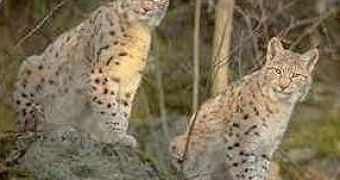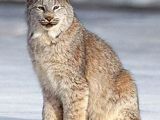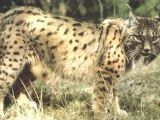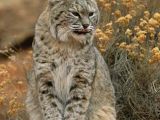The lynx is the "panther" of the northern forests, from Spain and European mountains to Siberia, Canada and Alaska. The best conditions for a lynx require the combination of two habitats: dense old forests, luxuriant and thick, for breeding and raising their offspring and rabbit/hare rich green pastures and young forests.
Adult lynxes are 6 times the size of a domestic cat and are taller than your knee level. In the case of the Eurasian lynx (Lynx lynx) living in the European mountains and Siberia, males weigh up to 30 kg (66 lb) and females up to 18 kg (40 lb), but the Canadian lynx (Lynx canadiensis) from Alaska and Canada is half this size: a maximum of 15 kg (33 lbs) in males and 10 kg (22 lbs) in females. The Canadian lynx is also somewhat more gray, while the Eurasian lynx is more brown-reddish. The bobcat (Lynx Rufus) from US and northern Mexico is also a lynx species. It is the smallest species: adult males are up to 30 pounds (14 kg) and females up to 20 pounds (9 kg).
There is also a fourth species, the Iberian lynx (Lynx pardinus) from south/central Spain and Portugal. It is almost as big as the Eurasian lynx (up to 25 kg (55 lbs)), with a much more vivid, leopard-like coat and thicker hair locks.
What clearly differentiates lynxes from other cats is their abundant hair on their cheeks. Their face is wider and shorter than in other felines, that's why they have a false and deceiving look of timid and almost tame. Another characteristic of the lynx is their black tipped tail, only 10 cm (4 in) long. Their ears are triangular and finish in black paintbrush. They act like antennae that locate sounds produced by small animals. In winter the lynx grows a thick and fine fur, up to 10 cm (4 in) long, paler than the summer coat.
Lynxes have very wide paws that enable them not to sink into the snow, acting like snowshoes, so they are rapid on the snow. Because their limbs are relatively long compared to other cats, they can reach great speed and make jumps 3 m (10 ft) long. Lynxes can also make acrobatic turns in the air in order to change direction during their chases, which are always short. If the lynx does not capture the hare/rabbit after executing five jumps it gives up the chase. That's why they have to attack 3-10 hares, 'till capturing one. The victim is killed with a bite at the throat.
Lynxes are solitary. They prefer to hunt in the evening and at dawn, but like all cats they can see even in very dim light (a lynx sees 6 times better than a human in the dark). This is due to a retina membrane, called tapetum, that makes all cats' eyes glow in the dark. A lynx can spot a mouse from a distance of 75 m (250 ft) and a hare from 300 m (1,000 ft) (this is thrice the length of a football field). That's why in Spain (lynx eyes) a person with a very sharp eyesight is called "ojos de lince".
Lynxes' favorite prey consists of hares/rabbits, but they are not picky and can also eat mice, voles, capercaillies, grouses, ducks, beavers, squirrels and even deer. A Canadian lynx must eat 2 hares every 3 days.
When the lynx female is ready to mate it emits chemical signals and meows to attract the males. After the mating she gives birth to about 4 offspring (but even 7 if the food abounds). If the food is scarce, the offspring will be smaller.
Lynxes are very sensitive to human presence (bobcat is an exception). Today, the Iberian lynx is the most menaced cat species in the world, included in the Red List of IUCN: there are only two surviving populations and less than 200 individuals (of which only 22-32 breeding females) in the southwestern Iberian peninsula.
A main cause for this situation is the plummeting rabbit population, due to infection with myxomatosis. Poaching and car crashes are also taking their toll. But the most severe threat is habitat fragmentation, due to the building of roadways.

 14 DAY TRIAL //
14 DAY TRIAL // 


